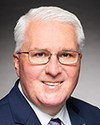To properly evaluate the services and training to be provided, we have to understand the suicidal individual's state of mind.
All suicidal individuals, be they military members or not, believe that they are worthless, that their situation will never change and that no one can help them. In that context, it becomes extremely difficult to seek help, to find it and to take a step toward a resource. It is even more difficult for men who conform to the traditional male role, where physical strength, autonomy, independence and solving one's own problems are valued. For someone who is going through a difficult time in their life when they think that they are worthless, that no one can help them and that the situation will never change, all those obstacles make it extremely difficult and painful to seek help.
However, in spite of their suffering, the individual will always feel ambivalent. This means that a part of them wants to stop suffering, and that is why they think about ending their life, but there is always a part of them that wants to live. That is the part that must be recognized by the individual in distress, and it is the responders' and professionals' job to help that part grow. Every time a suicidal person asks for help and shows their distress, the part that wants to live is expressing itself and continuing to hope.
As for many veterans—who are generally men—the characteristics of their way to seek help must be taken into consideration. That is true for suicide in general, and it is also true in the armed forces. A call for help will not manifest in the same way, and the way services are provided to them must also be adapted.
Research shows that, when a man conforms to the traditional male role, he is five times more likely to attempt suicide than a member of the general population. In the armed forces, a medical release is a failure of the system, but it is also a failure for the man who finds himself in a vulnerable situation. As that perception is generalized within himself and within his unit, he feels shame and has difficulty seeking help, as we were saying. Therefore, going from active military service to civilian life and becoming a veteran is a critical moment when the vulnerable soldier loses the strong and unified network with which he identified and participated in. So that will be an extremely difficult moment that must be anticipated and monitored, and that is why this consultation is important.
As you know, many services are provided by Veterans Affairs Canada. However, is sufficient training provided for the professionals who work in suicide prevention, the responders to whom our veterans can turn? Are they able to recognize signs of distress and act quickly?
A training initiative for Quebec citizens has a proven track record. “Agir en sentinelle pour la prévention du suicide”—acting as sentinels to prevent suicide—is a training initiative that is intended not for professionals but for anyone who wants to play a role in their community, in their spare time, with their work colleagues and their peers. It enables people to be proactive, identify signs of distress, refer the individual to help resources and go with them. That training works. It is effective and has already become entrenched in some military communities. It promotes timely identification and proactiveness.
In civil society as in specific communities, those sentinels must be able to rely on a designated responder. They must be supported in order to play their role and then be able to quickly help the suicidal individual connect with a responder who will provide a full intervention and decide what steps should be taken next.
Suicide prevention training is essential for responders and mental health professionals, as well as for physicians who work with military members and veterans. It should not be taken for granted that a physician, a nurse or a psychologist has received specialized training in suicide prevention. However, that type of training does exist, and it works.
The Quebec male suicide rate decreased significantly in the 2000s specifically thanks to a national strategy with training at its core. So we suggest that you make training a cornerstone of the next strategy for veterans.
Furthermore, we want to draw your attention to three major elements to consider with regard to the current services provided or with regard to what you could implement. General Dallaire referred to this earlier. I am talking about the importance of streamlining the services available to our active military members and veterans. That transition must go as smoothly as possible, so that, ultimately, the suicidal individual or military member who needs services, having successfully asked for help and found someone to help them and guide them in that endeavour, does not have to change responders or treatment teams and does not have to repeat their story, either before or after a suicide attempt.
To avoid that disconnect, we suggest that you consider a consolidation of Canadian Forces operational stress injury treatment centres and veterans centres, so that the treatment team would be the same. The therapeutic alliance is important. Veterans sometimes even go back to the same team and health professionals they dealt with when they were in active service.
We also talked about social support. General Dallaire mentioned that. We are talking about social support from families and peers, but also about support from the unit, as well as gathering around the forces and active military members. That support must be an integral part of care and of what professionals and responders propose to military members.
Men mainly turn to their spouse—sometimes exclusively—when they need emotional support. A separation occasionally occurs when they are not doing well. There may be additional problems, including mental health issues, alcoholism and substance abuse. All that puts considerable pressure on loved ones. That is why it is so important to take into account this reality in order to help military members and veterans recover.
The Canadian Armed Forces are a large and strong family. Each member can count on the others for their survival. The idea is to make sure that this strength and mutual support continue after release, whether that release has to do with medical issues or not.
In addition, we make recommendations when it comes to web-based prevention and online responses. Distress is increasingly manifesting on various platforms. People share their suicidal ideas and their distress on the web. That is especially true in the case of young people and isolated individuals, but that behaviour is becoming more prevalent among a variety of individuals. We feel that suicide prevention strategies must now take into account this reality by including a web component. That would enable people to share prevention messages, identify cases, be proactive and propose full response services online.
In closing, I want to reiterate the required elements of an effective suicide prevention strategy. First, all the stakeholders are concerned. Second, managers at various levels of the chain of command must undergo training, uphold the principle and demonstrate leadership. Third, professionals and responders must be provided with specific suicide prevention training. Fourth, the creation of sentinel networks must be supported. Fifth, strong and widespread social support must be established. Sixth, people must be provided with better education on mental health issues and be better informed on the help that may be provided. Calls for help must be encouraged to ultimately change cultures and mentalities. It is also important to pay attention to the messages and ceremonies, so that they would not increase the social acceptability of suicide. Of course, adequate funding is required to implement the proposed measures. Finally, accessible care adapted to the clientele for which it is intended is obviously required.
Thank you very much.




